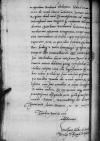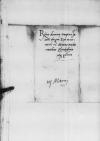 BCz, 1597, p. 523
BCz, 1597, p. 523
Reverendissime Domine, domine modis omnibus colendissime atque gratiosissime.
Obsequiorum meorum, tum mei ipsius sedula commendatione praemissa.
Accepi cf. Ioannes DANTISCUS to Stanisław KOSTKA shortly before 1539-02-23, CIDTC IDL 7215, letter lost⌊litterascf. Ioannes DANTISCUS to Stanisław KOSTKA shortly before 1539-02-23, CIDTC IDL 7215, letter lost⌋ Reverendissimae Dominationis Vestrae, quibus scribere dignetur se pecuniam contributionum cervisiarium collectam in promptu habere atque eam Mariemburgum iuxta mandatum sacrae maiestatis regiae, domini mei clementissimi, et pristinam consuetudinem mittere velle. Saltem illi scriptis meis declararem, quo me nunc loco contineam. Certiorem itaque reddo Reverendissimam Dominationem Vestram me Sabbato ante Dominicam Invocavit Marienburg (Malbork), town and castle in northern Poland, Pomeranian Voivodeship, on the Nogat river, a branch of the Vistula at its delta, the capital of the Grand Masters of the Teutonic Order in Prussia (1309-1457), a voivodeship capital in Royal Prussia, which belonged to the Kingdom of Poland (1466-1772). Marienburg (taking turns with Graudenz (Grudziądz)) was the venue for the Provincial Diets of Royal Prussia, which were chaired by the bishop of Ermland (Warmia)⌊MariemburgumMarienburg (Malbork), town and castle in northern Poland, Pomeranian Voivodeship, on the Nogat river, a branch of the Vistula at its delta, the capital of the Grand Masters of the Teutonic Order in Prussia (1309-1457), a voivodeship capital in Royal Prussia, which belonged to the Kingdom of Poland (1466-1772). Marienburg (taking turns with Graudenz (Grudziądz)) was the venue for the Provincial Diets of Royal Prussia, which were chaired by the bishop of Ermland (Warmia)⌋ contulisse. Quare Reverendissima Dominatio Vestra thesaurarium suum cum eisdem pecuniis atque recognitione huc recta mittere dignetur. Etiam si aliquis casus, qui saepe plus valet quam ratio interveniret, ut mihi abeundum foret, tamen sunt hic mei scribae, quibus id negotii delegatum est, hi easdem pecunias recepturi sunt atque Reverendissimam Dominationem Vestram nomine meo de summa accepta quittaturi.
Rerum novarum nihil omnino nunc habeo praeter ea, quae iam sunt vulgatissima. Serenissimi Sigismund I Jagiellon (Zygmunt I) (*1467 – †1548), King of Poland and Grand Duke of Lithuania (1506-1548); Duke of Głogów (Glogau) (1499-1506), Duke of Opava (1501-1506), Governor of Silesia (1504-1506); son of King Kazimierz IV Jagiellon and Elisabeth of Austria⌊regisSigismund I Jagiellon (Zygmunt I) (*1467 – †1548), King of Poland and Grand Duke of Lithuania (1506-1548); Duke of Głogów (Glogau) (1499-1506), Duke of Opava (1501-1506), Governor of Silesia (1504-1506); son of King Kazimierz IV Jagiellon and Elisabeth of Austria⌋ nostri Isabella Jagiellon (*1519 – †1559), 1539-1559 Queen of Hungary; from 1539 wife of John Zápolya, King of Hungary, mother of John II Sigismund Zápolya; daughter of Sigismund Jagiellon, King of Poland, and Bona Sforza⌊filiolamIsabella Jagiellon (*1519 – †1559), 1539-1559 Queen of Hungary; from 1539 wife of John Zápolya, King of Hungary, mother of John II Sigismund Zápolya; daughter of Sigismund Jagiellon, King of Poland, and Bona Sforza⌋ serenissimo John Zápolya (János Szapolyai) (*1487 – †1540), 1526-1540 King of Hungary; son of István Szapolyai and Jadwiga of Cieszyn in 1540 married Isabella, dauther of of King Sigismund Jagiellon of Poland. He fought against Ferdinand of Habsburg for the right to the title of King of Hungary⌊Ungariae regiJohn Zápolya (János Szapolyai) (*1487 – †1540), 1526-1540 King of Hungary; son of István Szapolyai and Jadwiga of Cieszyn in 1540 married Isabella, dauther of of King Sigismund Jagiellon of Poland. He fought against Ferdinand of Habsburg for the right to the title of King of Hungary⌋ in matrimonium elocatam atque Sabbato ante Purificationis Gloriosissimae Virginis ferias e Cracow (Kraków, Cracovia), city in southern Poland, Małopolska, on the Vistula river, from 1038 capital of the Kingdom of Poland⌊CracoviaCracow (Kraków, Cracovia), city in southern Poland, Małopolska, on the Vistula river, from 1038 capital of the Kingdom of Poland⌋ profectam, quam serenissimus Sigismund II Augustus Jagiellon (Zygmunt II August) (*1520 – †1572), 1529-1572 Grand Duke of Lithuania (ruled from 1544); 1530-1572 King of Poland (crowned vivente rege (ruled from 1548, after the death of his father); son of Sigismund I Jagiellon and Bona Sforza⌊rex iuniorSigismund II Augustus Jagiellon (Zygmunt II August) (*1520 – †1572), 1529-1572 Grand Duke of Lithuania (ruled from 1544); 1530-1572 King of Poland (crowned vivente rege (ruled from 1548, after the death of his father); son of Sigismund I Jagiellon and Bona Sforza⌋ una cum clementissima Bona Sforza (*1494 – †1557), Queen of Poland and Grand Duchess of Lithuania (1518-1557); the second wife of Sigismund I Jagiellon; Duchess of Bari and Rossano; daughter of Gian Galeazzo Sforza of Milan and Isabella of Aragon⌊parenteBona Sforza (*1494 – †1557), Queen of Poland and Grand Duchess of Lithuania (1518-1557); the second wife of Sigismund I Jagiellon; Duchess of Bari and Rossano; daughter of Gian Galeazzo Sforza of Milan and Isabella of Aragon⌋ usque  BCz, 1597, p. 524 in Bochnia, town on the river Raba in southern Poland, 35 km SE of Cracow, it is most noted for its salt mine, the oldest functioning one in Europe, built circa 1248⌊oppidum BochnensemBochnia, town on the river Raba in southern Poland, 35 km SE of Cracow, it is most noted for its salt mine, the oldest functioning one in Europe, built circa 1248⌋ deduxere. Haud etiam Reverendissimam Dominationem Vestram latere arbitror sacram Sigismund I Jagiellon (Zygmunt I) (*1467 – †1548), King of Poland and Grand Duke of Lithuania (1506-1548); Duke of Głogów (Glogau) (1499-1506), Duke of Opava (1501-1506), Governor of Silesia (1504-1506); son of King Kazimierz IV Jagiellon and Elisabeth of Austria⌊maiestatem regiamSigismund I Jagiellon (Zygmunt I) (*1467 – †1548), King of Poland and Grand Duke of Lithuania (1506-1548); Duke of Głogów (Glogau) (1499-1506), Duke of Opava (1501-1506), Governor of Silesia (1504-1506); son of King Kazimierz IV Jagiellon and Elisabeth of Austria⌋, dominum meum clementissimum, ad supplicem hidden by binding⌈[m]m hidden by binding⌉ intercessionem tam Isabella Jagiellon (*1519 – †1559), 1539-1559 Queen of Hungary; from 1539 wife of John Zápolya, King of Hungary, mother of John II Sigismund Zápolya; daughter of Sigismund Jagiellon, King of Poland, and Bona Sforza⌊reginaeIsabella Jagiellon (*1519 – †1559), 1539-1559 Queen of Hungary; from 1539 wife of John Zápolya, King of Hungary, mother of John II Sigismund Zápolya; daughter of Sigismund Jagiellon, King of Poland, and Bona Sforza⌋, quam oratorum Hungariae hidden by binding⌈[ae]ae hidden by binding⌉ domino Mikołaj Russocki (Mikołaj Rusocki) (*ca. 1491 – †1548), 1509 standard-bearer of Kalisz; 1511-1548 castellan of Biechów; 1520 starosta of Morąg; royal commander (chorąży); 1524-1537 starosta of Łęczyca; 1524-1537 - of Przedecz; 1532-1538 - of Rawa; 1526 royal envoy (together with Wawrzyniec Międzyleski) to the funeral of the last duke of Masovia Janusz (PSB 33/1, p. 150-152)⌊castellano BiechoviensiMikołaj Russocki (Mikołaj Rusocki) (*ca. 1491 – †1548), 1509 standard-bearer of Kalisz; 1511-1548 castellan of Biechów; 1520 starosta of Morąg; royal commander (chorąży); 1524-1537 starosta of Łęczyca; 1524-1537 - of Przedecz; 1532-1538 - of Rawa; 1526 royal envoy (together with Wawrzyniec Międzyleski) to the funeral of the last duke of Masovia Janusz (PSB 33/1, p. 150-152)⌋ leniorem et commodiorem sessionem assignasse, nempe conclave hidden by binding⌈[ve]ve hidden by binding⌉ sive caminatam, ut in litteris regiis expressum est, in superiori arce, in qua olim Pyenyązek detinetur hodieque e turri Kurzanoga egressus, reliqum hidden by binding⌈[um]um hidden by binding⌉ tempus illic transacturus.
BCz, 1597, p. 524 in Bochnia, town on the river Raba in southern Poland, 35 km SE of Cracow, it is most noted for its salt mine, the oldest functioning one in Europe, built circa 1248⌊oppidum BochnensemBochnia, town on the river Raba in southern Poland, 35 km SE of Cracow, it is most noted for its salt mine, the oldest functioning one in Europe, built circa 1248⌋ deduxere. Haud etiam Reverendissimam Dominationem Vestram latere arbitror sacram Sigismund I Jagiellon (Zygmunt I) (*1467 – †1548), King of Poland and Grand Duke of Lithuania (1506-1548); Duke of Głogów (Glogau) (1499-1506), Duke of Opava (1501-1506), Governor of Silesia (1504-1506); son of King Kazimierz IV Jagiellon and Elisabeth of Austria⌊maiestatem regiamSigismund I Jagiellon (Zygmunt I) (*1467 – †1548), King of Poland and Grand Duke of Lithuania (1506-1548); Duke of Głogów (Glogau) (1499-1506), Duke of Opava (1501-1506), Governor of Silesia (1504-1506); son of King Kazimierz IV Jagiellon and Elisabeth of Austria⌋, dominum meum clementissimum, ad supplicem hidden by binding⌈[m]m hidden by binding⌉ intercessionem tam Isabella Jagiellon (*1519 – †1559), 1539-1559 Queen of Hungary; from 1539 wife of John Zápolya, King of Hungary, mother of John II Sigismund Zápolya; daughter of Sigismund Jagiellon, King of Poland, and Bona Sforza⌊reginaeIsabella Jagiellon (*1519 – †1559), 1539-1559 Queen of Hungary; from 1539 wife of John Zápolya, King of Hungary, mother of John II Sigismund Zápolya; daughter of Sigismund Jagiellon, King of Poland, and Bona Sforza⌋, quam oratorum Hungariae hidden by binding⌈[ae]ae hidden by binding⌉ domino Mikołaj Russocki (Mikołaj Rusocki) (*ca. 1491 – †1548), 1509 standard-bearer of Kalisz; 1511-1548 castellan of Biechów; 1520 starosta of Morąg; royal commander (chorąży); 1524-1537 starosta of Łęczyca; 1524-1537 - of Przedecz; 1532-1538 - of Rawa; 1526 royal envoy (together with Wawrzyniec Międzyleski) to the funeral of the last duke of Masovia Janusz (PSB 33/1, p. 150-152)⌊castellano BiechoviensiMikołaj Russocki (Mikołaj Rusocki) (*ca. 1491 – †1548), 1509 standard-bearer of Kalisz; 1511-1548 castellan of Biechów; 1520 starosta of Morąg; royal commander (chorąży); 1524-1537 starosta of Łęczyca; 1524-1537 - of Przedecz; 1532-1538 - of Rawa; 1526 royal envoy (together with Wawrzyniec Międzyleski) to the funeral of the last duke of Masovia Janusz (PSB 33/1, p. 150-152)⌋ leniorem et commodiorem sessionem assignasse, nempe conclave hidden by binding⌈[ve]ve hidden by binding⌉ sive caminatam, ut in litteris regiis expressum est, in superiori arce, in qua olim Pyenyązek detinetur hodieque e turri Kurzanoga egressus, reliqum hidden by binding⌈[um]um hidden by binding⌉ tempus illic transacturus.
Quae omnia quamvis for hidden by binding⌈[for]for hidden by binding⌉san iamdudum fuere notissima Reverendissimae Dominationi Vestrae, tamen meum debitum quoque exposcebat, ut in hidden by binding⌈[n]n hidden by binding⌉ itidem scriptis meis illi significarem. Cui in omni hidden by binding⌈[mni]mni hidden by binding⌉bus rebus perhibens sum morem gesturus. Cu hidden by binding⌈[u]u hidden by binding⌉pio tandem Reverendissimam Dominationem Vestram optime et felicissime cum suis omnibus in annos longissimos hidden by binding⌈[s]s hidden by binding⌉ ex animo valere. Cui me iterum atque iterum promptissimis obsequiolis meis quam diligentissime com hidden by binding⌈[om]om hidden by binding⌉mendo.
 BCz, 1597, p. 524 in
BCz, 1597, p. 524 in 

